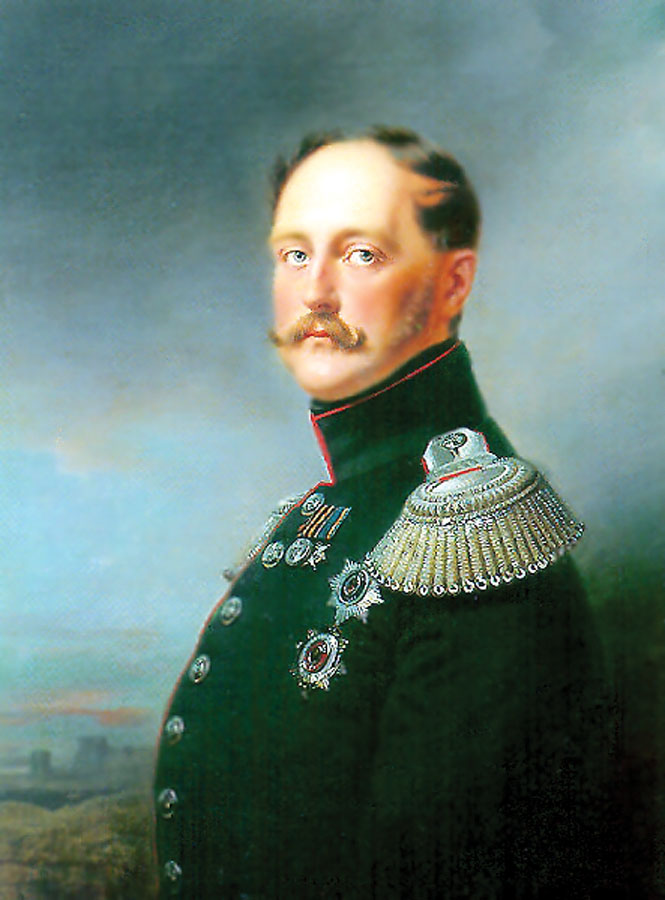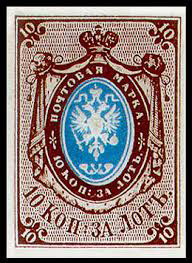The stamps of Imperial Russia

In 1613, with the help of the minor nobility, Mikhail Feodorovic Romanov became Tsar and founded a dynasty which ruled Russia for three centuries. A Russian resurgence – one of many over the centuries, but one which gave a remarkable impetus to the growth of the Russian empire – began when Peter the Great took power in 1696. It was under him that Russia won an outlet to the Baltic; he founded the city of St Petersburg; he won the war with Sweden which added Karelia, Ingria, Estonia and Livonia; he reorganized the army and created a powerful fleet. Russia’s territory spread yet further following the Napoleonic era with the acquisition of Finland, Bessarabia and a large part of Poland. Later, however, there were reverses in the Crimean and Russo-Japanese Wars. And so we come to the 20th century, when Russia was the only transcontinental power and ruled over a total of over 22.5 million square kilometres and some 170 million people. The Russian Empire, though, was not so much a truly united country as an inorganic ensemble of states, races, nations, and communities great and small, separated by great distances and dissimilarities of culture and tradition, and held together by nothing more than an extremely authoritarian political structure. The time was ripe, then, for a revolution which not only upset Russia itself but had important historic consequences for all the world. The first Postal Service The first regular postal service for communications between Moscow and Courland (modern Latvia) goes back to 1666. The St Petersburg post office opened in 1716 and was followed by others in major centres elsewhere: Moscow, Riga, Archangel and so on. It was only in the final decades of the 18th century that a fairly widespread network of real post offices came in to being, taking the place of the earlier post stations, which had merely seen to the availability of fresh horses (or other animals) used to carry the mail. Even under the reign of Nicholas I, who became Tsar in 1825, postal communication was almost entirely restricted to members of the nobility and the great merchants, while international traffic was extremely limited. As a result, postal documents of the period before postage stamps must always be regarded as quite rare. We know of an ordinance of 6 December 1839 which prescribed postal charges due to come into force the next 1 January; the interesting thing about this tariff is that the charge varied with distance. Up to the rough equivalent of 500 kilometres, a letter cost five kopecks; above that, there was a long scale up to a maximum of 25 kopecks, the charge for distances greater than (about) three thousand kilometres. These tariffs, however, were thought too high; and in 1843 it was decided to set the charge for a letter at ten kopecks regardless of the distance from origin to destination though the charge did vary according to weight. This was without doubt an effect of the interest aroused in Russia by the postal reform in the United Kingdom. Indeed there was also consideration of the possibility of providing for payment at the origin; and the obvious consequence was a rapid transition to the issue of prestamped mail. There was no thought at first of adhesive stamps, but only of issuing franked envelopes. The first of these came out in 1845 to meet the needs of the urban postal services of St Petersburg and (the next year) of Moscow. Just three years later, envelopes were issued which made it possible to correspond with anywhere in the empire. The first St Petersburg postal stationery appeared on 1 December 1845. The printed stamp was a reproduction of the imperial emblem (the double-headed eagle) and the franked envelope cost 6 kopecks: five for the postage and one for the cost of the envelope. Russian postcards, on the other hand, first appeared in 1872 at a cost of 3 or 5 kopecks, the former for the “local” area and the latter for “general” postage. In 1875, when postage charges were reduced, the 5 kopeck card was replaced by a 4 kopeck one. Lastly, the first replypaid cards were issued in 1886. The Classic Stamps The first regular postal service for communications between Moscow and Courland (modern Latvia) goes back to 1666. The St Petersburg post office opened in 1716 and was followed by others in major centres elsewhere: Moscow, Riga, Archangel and so on. It was only in the final decades of the 18th century that a fairly widespread network of real post offices came in to being, taking the place of the earlier post stations, which had merely seen to the availability of fresh horses (or other animals) used to carry the mail. Even under the reign of Nicholas I, who became Tsar in 1825, postal communication was almost entirely restricted to members of the nobility and the great merchants, while international traffic was extremely limited. As a result, postal documents of the period before postage stamps must always be regarded as quite rare. We know of an ordinance of 6 December 1839 which prescribed postal charges due to come into force the next 1 January; the interesting thing about this tariff is that the charge varied with distance. Up to the rough equivalent of 500 kilometres, a letter cost five kopecks; above that, there was a long scale up to a maximum of 25 kopecks, the charge for distances greater than (about) three thousand kilometres. These tariffs, however, were thought too high; and in 1843 it was decided to set the charge for a letter at ten kopecks regardless of the distance from origin to destination though the charge did vary according to weight. This was without doubt an effect of the interest aroused in Russia by the postal reform in the United Kingdom. Indeed there was also consideration of the possibility of providing for payment at the origin; and the obvious consequence was a rapid transition to the issue of prestamped mail. There was no thought at first of adhesive stamps, but only of issuing franked envelopes. The first of these came out in 1845 to meet the needs of the urban postal services of St Petersburg and (the next year) of Moscow. Just three years later, envelopes were issued which made it possible to correspond with anywhere in the empire. The first St Petersburg postal stationery appeared on 1 December 1845. The printed stamp was a reproduction of the imperial emblem (the double-headed eagle) and the franked envelope cost 6 kopecks: five for the postage and one for the cost of the envelope. Russian postcards, on the other hand, first appeared in 1872 at a cost of 3 or 5 kopecks, the former for the “local” area and the latter for “general” postage. In 1875, when postage charges were reduced, the 5 kopeck card was replaced by a 4 kopeck one. Lastly, the first replypaid cards were issued in 1886.
Author: A. Arseni

